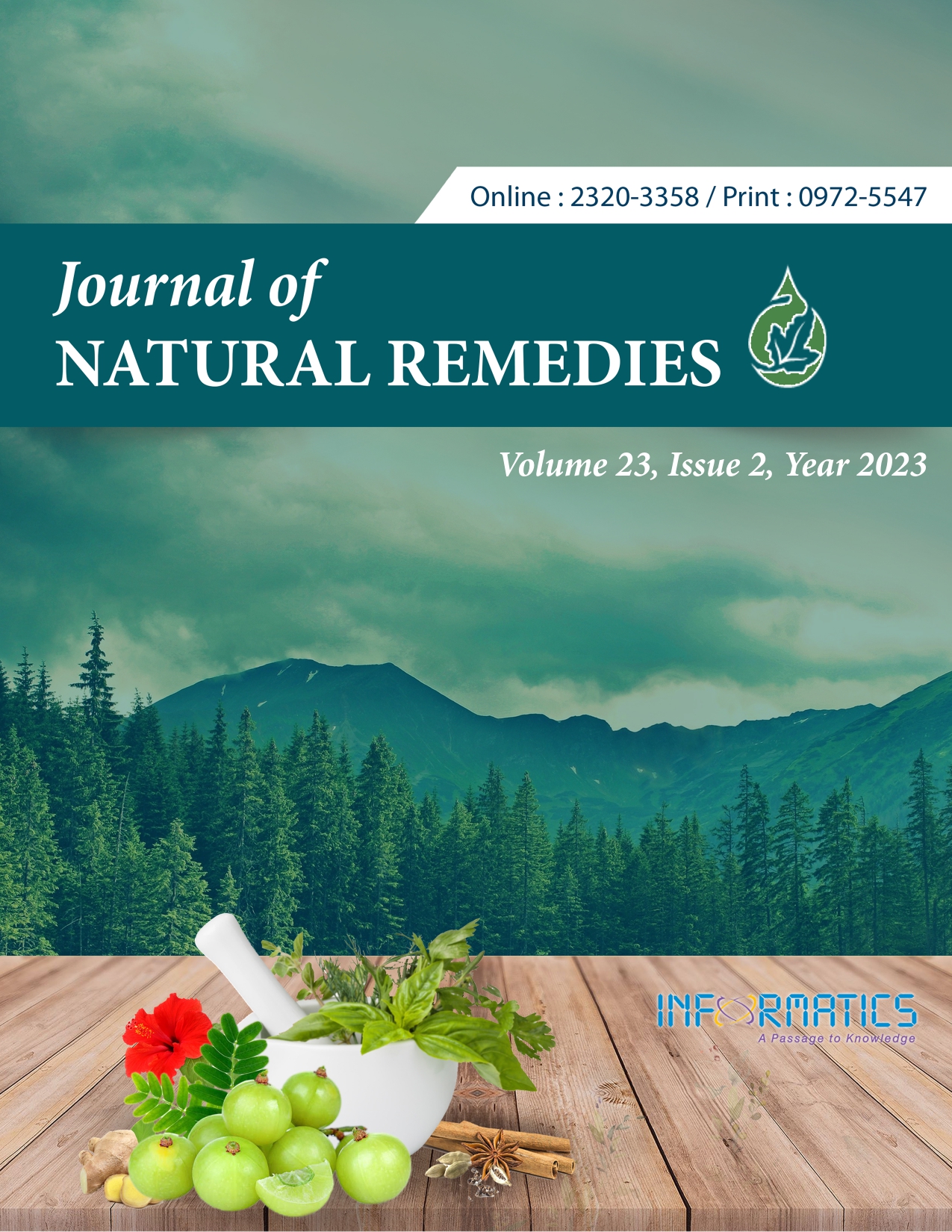A Molecular Docking Investigation of SARS- CoV-2’s Main Protease against Phytocomponents of Siddha Formulation Vishasura Kudineer
DOI:
https://doi.org/10.18311/jnr/2023/29245Keywords:
Ayush, COVID-19, Molecular Docking, Network Pharmacology, Siddha MedicineAbstract
Background: Covid-19 disease is a Wuhan, China originated acute viral respiratory illness. Even though the development of numerous vaccines, the threat of the Covid-19 virus endures nearly two years after the outbreak. The new mutant strain omicron has now spread to several countries. As a result, newer antiviral therapy is required to overcome this scenario. Objective: This study is aimed at phytocomponents in the Siddha formulation, Vishasura Kudineer (VSK), it is widely used to manage fever and respiratory ailments and may be effective in combating the ongoing pandemic of novel coronavirus disease. Methodology: The principal protease 3CLpro of this new Coronavirus (SARS-CoV-2) is a possible focus for therapeutic development since it plays a major part in disease transmission. Molecular docking investigation for all active Phytocomponents found in the Siddha formulation Vishasura Kudineer with possible targets was carried in the major Protease of SARS-CoV-2 (PDB ID:6LU7). AutoDockTools was used to design and optimize the ligand structures. Results: Molecular docking of the 9 bioactive phytocomponents as Santalic acids (-6.39), Nimbolide (-6.38), Rutin, Aristolochic acid (-6.95), Glabridin (-7.53), Indirubin (-7.23), Sabinene (-5.36), β-vetivenene (-6.79), and Zingiberene (-6.47) from in the Siddha sastric formulation, Vishasura Kudineer performed on the SARS-CoV-2 Main Protease protein’s active site (PDB ID: 6LU7). These phytochemicals had significant molecular interaction with the active residues, indicating their distinct inhibitory potencies. Conclusion: Whether this Siddha formulation could be used to effectively treat and manage COVID-19 and its variants, further research and clinical studies need to be done.
Downloads
Metrics
Downloads
Published
How to Cite
Issue
Section
License
Copyright (c) 2023 KARTHIK NAGARAJAN S, Karthik Nagarajan S, Bakkiya Devi M, Thillaivanan S, Maanickha chelvi K.S, Kanagarajan A

This work is licensed under a Creative Commons Attribution 4.0 International License.
Accepted 2023-05-03
Published 2023-06-13
References
Muhammad Adnan Shereen, et al. COVID-19 infection: Emergence, transmission, and characteristics of human coronaviruses. Journal of Advanced Research. 2020; 91-98.https://doi.org/10.1016/j.jare.2020.03.005 DOI: https://doi.org/10.1016/j.jare.2020.03.005
Rothe C, et al. Transmission of 2019-nCoV infection from an asymptomatic contact in Germany. N Engl J Med. 2020; 382:970-1. https://doi.org/10.1056/NEJMc2001468 DOI: https://doi.org/10.1056/NEJMc2001468
Huang C, Wang Y, Li X, Ren L, Zhao J, Hu Y. Clinical features of patients infected with 2019 novel coronavirus in Wuhan, China. Lancet. 2020. https://doi.org/10.1016/S0140-6736(20)30183-5 DOI: https://doi.org/10.1016/S0140-6736(20)30183-5
Covid-19.who.int. 2020. WHO Coronavirus Disease (COVID-19) Dashboard. [Online] Available from: https://covid19.who.in.
My Gov. in. 2020. #Indiafightscorona COVID-19. [Online] Available from: https://www.mygov.in/covid-19.
Muthiah K, Ganesan K, Ponnaiah M, Parameswaran S. Concepts of body constitution in traditional Siddha texts: A literature review. Journal of Ayurveda and Integrative Medicine. 2019; 10(2):131-4. https://doi.org/10.1016/j.jaim.2019.04.002 DOI: https://doi.org/10.1016/j.jaim.2019.04.002
Nagappan AG, Krishnaveni M, Monika T, Thillaivanan S, Selvamoorthy G. A molecular docking study of SARS-CoV-2 main protease against phytochemicals of Siddha Medicinal herb Vilvam (Aeglemarmelos). International Journal of Ayurvedic Medicine. 2021; 12(3):506-512. https://doi.org/10.47552/ijam.v12i3.2138 DOI: https://doi.org/10.47552/ijam.v12i3.2138
Kiran G, et al. In Silico computational screening of Kabasura- Official Siddha formulation and JACOM against SARS-CoV-2 spike protein, J Ayurveda Integr Med. https://doi.org/10.1016/j.jaim.2020.05.009 DOI: https://doi.org/10.1016/j.jaim.2020.05.009
Sabarianandh JV, Bernaitis L, Manimekalai K. COVID-19 in Siddha medicine: A review. SBV Journal of Basic, Clinical and Applied Health Science. 2020; 3(2):83-86. https://doi.org/10.5005/jp-journals-10082-02256 DOI: https://doi.org/10.5005/jp-journals-10082-02256
Trott O, Olson AJ. AutoDockVina: Improving the speed and accuracy of docking with a new scoring function, efficient optimization, and multithreading. Journal of Computational Chemistry. 2010; 31(2):455-461. https://doi.org/10.1002/jcc.21334 DOI: https://doi.org/10.1002/jcc.21334
Berman HM, Westbrook J, Feng Z, Gilliland G, Bhat TN, Weissig H, Shindyalov IN, Bourne PE. The protein data bank. Nucleic Acids Research. 2000; 28(1):235-242. https://doi.org/10.1093/nar/28.1.235 DOI: https://doi.org/10.1093/nar/28.1.235
Morris GM, Goodsell DS, et al. Automated docking using a Lamarckian genetic algorithm and an empirical binding free energy function. Journal of Computational Chemistry. 1998; 19(14):1639-1662. https://doi.org/10.1002/(SICI)1096-987X(19981115) 19:14<1639::AID-JCC10>3.0.CO;2-B DOI: https://doi.org/10.1002/(SICI)1096-987X(19981115)19:14<1639::AID-JCC10>3.0.CO;2-B
Solis FJ, Wets RJB. Minimization by Random Search Techniques. 1981; 6(1):19-30. Available from: http://www.jstor.org/stable/3689263. https://doi.org/10.1287/moor.6.1.19 DOI: https://doi.org/10.1287/moor.6.1.19
Alzohairy MA. Therapeutics role of Azadirachta indica (Neem) and their active constituents in diseases prevention and treatment. Evidence-Based Complementary and Alternative Medicine. 2016; 7382506:11. https://doi.org/10.1155/2016/7382506 DOI: https://doi.org/10.1155/2016/7382506
Warjeet S Laitonjam, et al. Comparative study of the major components of the indigo dye obtained from Strobilanthes flaccidifolius Nees and Indig oferatinctoria Linn. International Journal of Plant Physiology and Biochemistry. 2011; 3(7):108-116.
Rampogu S, Baek A, Gajula RG, et al. Ginger (Zingiber officinale) phytochemicals-gingerenone-A and shogaol inhibit SaHPPK: molecular docking, molecular dynamics simulations and in vitro approaches. Ann Clin Microbiol Antimicrob. 2018; 17(1):16. https://doi.org/10.1186/s12941-018-0266-9 DOI: https://doi.org/10.1186/s12941-018-0266-9
Aneja V, et al. Plant review. Phyto-pharmacology of Hemidesmus indicus. Pharmacognosy Reviews. 2008; 2(3):143-150. DOI: https://doi.org/10.3923/jps.2008.146.156
Bharathajothi P, Bhaaskaran CT. Phytochemical and pharmacological evaluations of Aristolochia bracteolata Lam. Asian Journal of Plant Science and Research. 2014; 4(6):15-19.
Champagnat P. A Study on the composition of commercial Vetiveria zizanioides oils from different geographical origins. Journal of Essential Oil Research. 2011; 416-422. https://doi.org/10.1080/10412905.2006.9699129 DOI: https://doi.org/10.1080/10412905.2006.9699129
Pastorino G, Cornara L, Soares S, Rodrigues F, Oliveira MBPP. Licorice (Glycyrrhiza glabra): A phytochemical and pharmacological review. Phytother Res. 2018; 32(12):2323-2339. https://doi.org/10.1002/ptr.6178 DOI: https://doi.org/10.1002/ptr.6178
Ashokkumar K, et al. Phytochemical variations among four distinct varieties of Indian cardamom Elettaria cardamomum (L.) Maton. Nat Prod Res. 2020; 34(13):1919-1922. https://doi.org/10.1080/14786419.2018.1561687 DOI: https://doi.org/10.1080/14786419.2018.1561687
Vadnere GP. Phytochemical Investigation and in-vitro antimicrobial screening of santalum album seeds extracts. International Journal of Pharmacy and Pharmaceutical Sciences. 2017; 9(10):117-24. https://doi.org/10.22159/ijpps.2017v9i11.21216 DOI: https://doi.org/10.22159/ijpps.2017v9i11.21216
Maurya DK. Evaluation of Yashtimadhu (Glycyrrhiza glabra) active phytochemicals against Novel Coronavirus (SARS-CoV-2). Austin J Pharmacol Ther. 2021; 9(6):1153. https://doi.org/10.26420/ austinjpharmacolther.2021.1153 DOI: https://doi.org/10.26420/austinjpharmacolther.2021.1153
Foka FET, Manamela N, Mufamadi SM, Mufhandu HT. Potential of Azadirachta indica as a capping agent for antiviral nanoparticles against SARS-CoV-2. Biomed Res Int. 2022; 5714035. PMID: 36158879; PMCID: PMC9499809. https://doi.org/10.1155/2022/5714035 DOI: https://doi.org/10.1155/2022/5714035
Ahkam, Ahmad, Hermanto E, Feri, Alamsyah, Adzral, Aliyyah, Iva, Fatchiyah, Fatchiyah. Virtual prediction of antiviral potential of ginger (Zingiber officinale) bioactive compounds against spike and MPro of SARS-CoV2 protein. Berkala Penelitian Hayati. 2020; 25:52-57. https://doi.org/10.23869/bphjbr.25.2.20207 DOI: https://doi.org/10.23869/bphjbr.25.2.20207

 S. Karthik Nagarajan
S. Karthik Nagarajan









 0.35
0.35 24
24 0.161
0.161